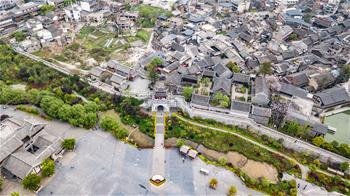SAN FRANCISCO CITY, the Philippines, April 11 (Xinhua) -- Olener Sacal and Given Lanugan said they were "mere construction laborers" when they were first enrolled to build a Chinese-funded drug rehabilitation center in San Francisco city in southern Philippines, in February 2018.
However, after a year on the construction project, they have learnt new skills and techniques from their Chinese mentors, and both Sacal and Lanugan said they were already promoted to carpenter and masonry respectively.
"I learned a lot from my Chinese supervisor who taught me how to do plastering, piling and lay-outing the proper way," Lanugan, 26, told Xinhua.
He said his Chinese supervisor cannot speak English but he demonstrated to him the craft of masonry repeatedly. "He would literally show me how to do it by doing it himself," he added.
Sacal, 32, said his Chinese mentor taught him carpentry skills including how to cut, measure and install beams and the proper way of erecting posts, which he never learned before.
"My supervisor was very patient in imparting his knowledge to us. He cannot speak the English language so he uses sign language. But to make sure that we understand his instructions, he often demonstrated how to do things properly," Sacal told Xinhua.
Lanugan and Sacal were among more than 400 Filipino workers that built the Chinese-funded drug treatment and rehabilitation center in San Francisco city of Agusan del Sur province, a landlocked province of the Philippines located in Mindanao.
The 6,750-square-meter facility that sits on a three-hectare lot is the second rehabilitation project funded by China to help the Philippines in its fight against illicit drugs.
A similar Chinese-funded facility in Sarangani province, also in Mindanao, was handed over to the Philippine government in December last year.
Amid warm relations between Beijing and Manila, 50 large Chinese companies are currently doing business in the Philippines, providing jobs to some 14,000 Filipinos, while 1,300 highly-skilled Chinese employees are here to help train local workers, according to the Chinese Enterprises Philippine Association.
One of these companies is the China State Construction Engineering Corporation (CSCEC), which built the newly-inaugurated drug rehabilitation center in Agusan del Sur. The facility which has a 150-bed capacity also has an administration office, a clinic, a multi-purpose covered court, dormitories, and a house for visitors.
Liu Wei, general manager of CSCEC Philippine branch, said his company hired more than 400 local workers and administrative staff to ensure that residents in the province benefit from the project. He said only 35 Chinese employees were involved in the project, including the supervisors of Lanugan and Sacal.
Liu said around 540 million pesos (around 10.4 million U.S. dollars) worth of Philippine materials and equipment were purchased and used in the project, including construction materials, machinery, furniture and medical equipment.
Philippine President Rodrigo Duterte vowed to end the drug menace in the country when he assumed the presidency on June 30, 2016. In October 2016, Duterte visited China and both sides reached an agreement to build drug rehabilitation centers in the Philippines.
Now the two newly-inaugurated drug rehabilitation centers not only can accommodate local drug dependent personnel but also help hundreds of local workers gain better skills after the construction process.
Edward Plaza, governor of Agusan del Sur province, said the construction of the drug rehabilitation center in Mindanao has provided jobs to Filipinos albeit temporarily. And because of the experience and the new skills the workers learned from the Chinese company and colleagues, these workers can easily find new jobs in the construction industry, he said.
"They are going to be better skilled because they are trained by our Chinese engineers. I believe they will be in demand from our local contractors," Plaza told Xinhua.
Armed with new skills, both Lanugan and Sacal said they have now more chances of getting a job in the construction industry. "We have more opportunities now," Sacal said.

















